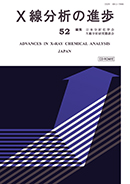Current issue
Displaying 1-23 of 23 articles from this issue
- |<
- <
- 1
- >
- >|
Review Article (Invited)
-
2021 Volume 52 Pages 1-14
Published: March 31, 2021
Released on J-STAGE: April 12, 2023
Download PDF (5694K) -
2021 Volume 52 Pages 15-23
Published: March 31, 2021
Released on J-STAGE: April 12, 2023
Download PDF (3752K) -
2021 Volume 52 Pages 25-32
Published: March 31, 2021
Released on J-STAGE: April 12, 2023
Download PDF (3197K) -
2021 Volume 52 Pages 33-48
Published: March 31, 2021
Released on J-STAGE: April 12, 2023
Download PDF (3129K)
Instrumentation & Experimental Technique
-
2021 Volume 52 Pages 49-54
Published: March 31, 2021
Released on J-STAGE: April 12, 2023
Download PDF (2316K) -
2021 Volume 52 Pages 55-62
Published: March 31, 2021
Released on J-STAGE: April 12, 2023
Download PDF (2993K) -
2021 Volume 52 Pages 63-68
Published: March 31, 2021
Released on J-STAGE: April 12, 2023
Download PDF (1481K) -
2021 Volume 52 Pages 69-80
Published: March 31, 2021
Released on J-STAGE: April 12, 2023
Download PDF (7470K) -
2021 Volume 52 Pages 81-111
Published: March 31, 2021
Released on J-STAGE: April 12, 2023
Download PDF (28563K) -
2021 Volume 52 Pages 113-126
Published: March 31, 2021
Released on J-STAGE: April 12, 2023
Download PDF (3694K) -
2021 Volume 52 Pages 127-138
Published: March 31, 2021
Released on J-STAGE: April 12, 2023
Download PDF (4001K)
Analytical Application
-
2021 Volume 52 Pages 139-149
Published: March 31, 2021
Released on J-STAGE: April 12, 2023
Download PDF (4594K) -
2021 Volume 52 Pages 151-160
Published: March 31, 2021
Released on J-STAGE: April 12, 2023
Download PDF (3131K) -
2021 Volume 52 Pages 161-166
Published: March 31, 2021
Released on J-STAGE: April 12, 2023
Download PDF (2563K) -
2021 Volume 52 Pages 167-177
Published: March 31, 2021
Released on J-STAGE: April 12, 2023
Download PDF (3941K) -
2021 Volume 52 Pages 179-198
Published: March 31, 2021
Released on J-STAGE: April 12, 2023
Download PDF (14372K) -
2021 Volume 52 Pages 199-206
Published: March 31, 2021
Released on J-STAGE: April 12, 2023
Download PDF (3760K) -
2021 Volume 52 Pages 207-215
Published: March 31, 2021
Released on J-STAGE: April 12, 2023
Download PDF (9369K) -
2021 Volume 52 Pages 217-227
Published: March 31, 2021
Released on J-STAGE: April 12, 2023
Download PDF (3664K) -
2021 Volume 52 Pages 229-242
Published: March 31, 2021
Released on J-STAGE: April 12, 2023
Download PDF (2753K) -
2021 Volume 52 Pages 243-256
Published: March 31, 2021
Released on J-STAGE: April 12, 2023
Download PDF (5891K)
Conference Reports
-
2021 Volume 52 Pages 257-259
Published: March 31, 2021
Released on J-STAGE: April 12, 2023
Download PDF (1525K) -
2021 Volume 52 Pages 261-265
Published: March 31, 2021
Released on J-STAGE: April 12, 2023
Download PDF (1196K)
- |<
- <
- 1
- >
- >|
